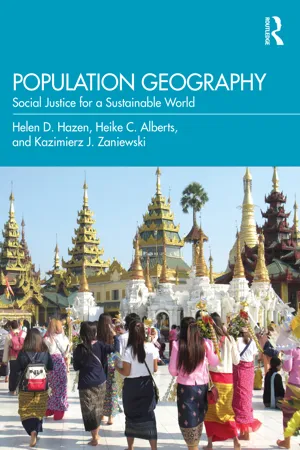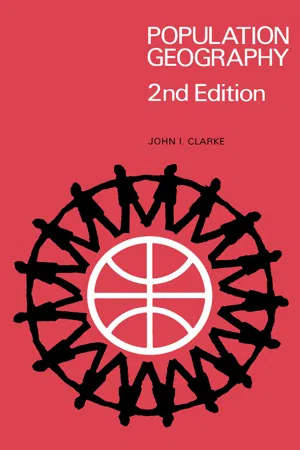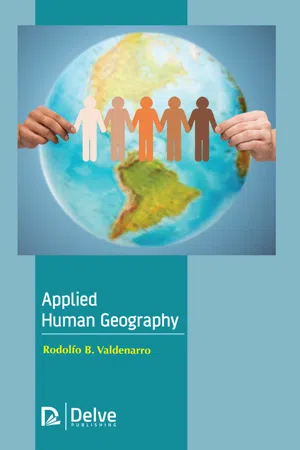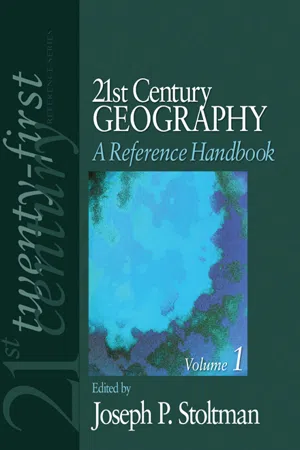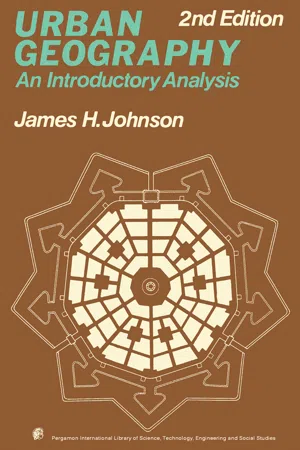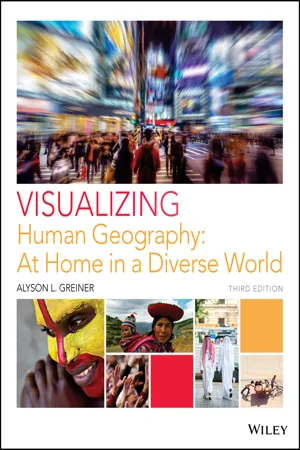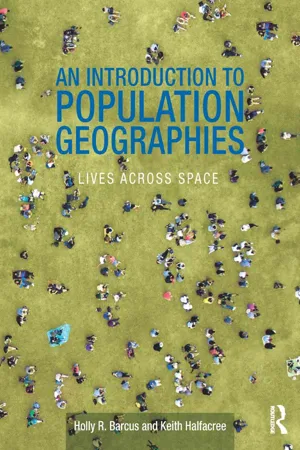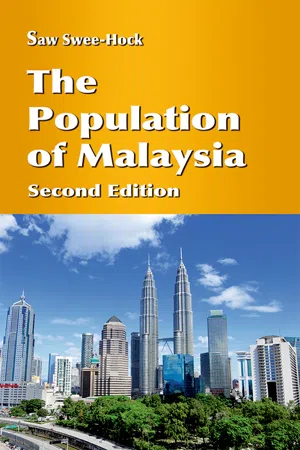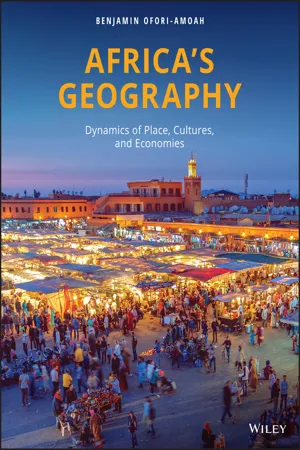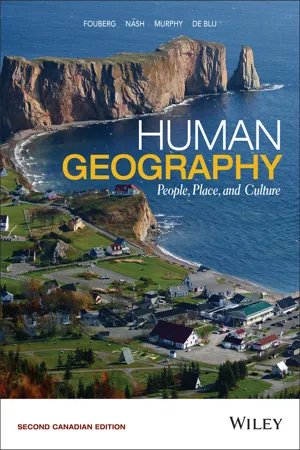Geography
Population Composition
Population composition refers to the structure of a population in terms of various demographic characteristics such as age, gender, ethnicity, education, and occupation. It provides insights into the distribution and diversity within a population, which is crucial for understanding social dynamics, economic patterns, and planning for public services and infrastructure.
Written by Perlego with AI-assistance
Related key terms
1 of 5
11 Key excerpts on "Population Composition"
- eBook - ePub
Population Geography
Social Justice for a Sustainable World
- Helen D. Hazen, Heike C. Alberts, Kazimierz J. Zaniewski(Authors)
- 2023(Publication Date)
- Routledge(Publisher)
digital nomads —people who work remotely from coffee shops, co-working spaces, recreational vehicles, and even abroad—has been increasing for some time. Their numbers thus far are too small to amount to a significant population shift but may lead to meaningful population redistributions in the long term. These movements are also important beyond the small number of people involved because they highlight significant inequalities among population groups, with stark divides emerging between those who are able to work remotely and those who cannot and between those who have the economic means to seek out desirable locations and those who do not. These shifts also contribute to important changes in Population Composition, as booming towns receive an influx of economically successful professional workers, whereas declining industrial areas are left with poorer, less skilled, and older populations. Aspects such as this help illustrate why the composition of population is such an important issue—it is to this topic that we turn next.PART II: Population Composition
Population geographers commonly study age, sex, and ethnic/racial compositions of populations, but many other population characteristics can be considered, including religion, language, and socio-economic status, or even literacy rates and access to clean water. Knowledge about Population Composition is not just an academic exercise but can also point to real-world problems such as a shortage of schools or inadequate sanitation. In the remainder of this chapter we explore age, sex/gender, and ethnicity/race as primary characteristics of Population Composition.Age structure
Age structure provides important information about the characteristics of populations because people of different ages play very different roles in society. Children are dependent on the broader population for support and may spend considerable time in education (box 3.1 ). Young adults are some of the most dynamic members of society, driving economic migration flows and providing labor and tax revenue to fuel the economy. Many people also become parents in their 20s or 30s, so a large young adult population increases fertility rates. By middle age, women are moving beyond their childbearing years but continue to play a critical role in childrearing. In middle age, many people also have eldercare responsibilities and may find themselves in the sandwich generation , concurrently performing childcare and eldercare roles, with clear physical and socio-emotional tolls (Buchanan 2013 - eBook - PDF
Population Geography
Pergamon Oxford Geographies
- John I. Clarke, W. B. Fisher(Authors)
- 2013(Publication Date)
- Pergamon(Publisher)
C H A P T E R VI PATTERNS O F Population Composition So FAR in this book we have largely ignored the individuality of human beings and the diversity of communities; we have treated man as a unit. We realize, however, that the population of the world is so varied physically, socially, econontically, and politically that satisfactory classification is almost im-possible. The problem has been further aggravated by varied definitions and connotations of terms like marriage, divorce, family, household, industry, nationality, language, religion, race, class, culture. Data are therefore variable, and international comparability low. Another difíiculty is that of isolating any particular aspect of population; how can one consider size of families without an examination of age-structure, and how can one understand social class without study of occupation and income ? Population Composition The composition of the population, or the population struaure, refers to those aspects of population which may be measured, however inadequately. But we must restrict ourselves to aspects for which data are usually obtained from censuses: age, sex, marital status, the size and composition of families and households, economic activities, nationality, language and religion. These are sometimes termed the quantitative aspects, in contrast to qualitative aspects such as physical and psychological characteristics and social and cultural groupings. It is also possible to distinguish between those aspects which are innate (sex, age, race) and those which are acquired during life (marriage, family, occupation), as well as between those which are individual and those which are communal. Geographers are interested in population structure as it varies territorially between countries, regions, urban and rural areas, communities and ethnic groups. - eBook - PDF
- Rodolfo B. Valdenarro(Author)
- 2019(Publication Date)
- Delve Publishing(Publisher)
Population Geographies 6 CONTENTS 6.1. Introduction .................................................................................... 116 6.2. Development of Population Geography .......................................... 118 6.3. Different Variations of Population Geography ................................. 122 6.4. The Importance of Density And Composition .................................. 124 6.5. Recent Developments In Population Geography ............................. 126 6.6. Scope of Population Geography ...................................................... 128 6.7. Important Aspects of Population Geography ................................... 129 6.8. Contemporary Population Geography ............................................. 132 Applied Human Geography 116 Population geographies have explained the concepts that had led to the improper population division all over the world. The field of Population Geography primarily lays its focus on the researches and studies of the allocation, dispersal and density of the population in any specific area all over the world. In addition to the allocation and density of the people all over the world, the discipline of population geography aims on observing the factors that affect the variations in that have been observed in the size of the population all over the world, fluctuations and attributes such as the structures, human activity, human migration and a number of activities that have been registered in the modern times. Population geography studies the aspects of the geography that has been linked with the human beings. Population geography helps the experts in understanding how the geography has changed with the sudden increase on the population all over the world and how these changes will return back to the human beings. - eBook - PDF
- R. Knowles, J. Wareing(Authors)
- 2014(Publication Date)
- Made Simple(Publisher)
PART TWO : POPULATION GEOGRAPHY CHAPTER FIVE POPULATION DISTRIBUTION Until quite recently the systematic study of population had been largely neglected by geographers, in contrast with other fields of human geography such as agriculture, industry and settlement which have a long-established tradition of systematic analysis. However, in recent years there has been a growing awareness of the importance of population studies within the broad framework of human geography. Population geography has rapidly advanced from a peripheral position within the discipline to the stage where it has been claimed that 'numbers, densities and qualities of the population provide an essential background for all geography. Population is the point of reference from which all the other elements are observed and from which they all, singly and collectively, derive significance and meaning. It is population which furnishes the focus.* (G. T. Trewartha) Population geography is concerned with the study of demographic processes and their consequences in an environmental context. It may thus be distin-guished from demography by its emphasis on the spatial variations in the growth, movement and composition of populations, and its concern with the social and economic implications of these variations. The development of the subject has been severely limited by a lack of demographic data for many parts of the world, but, like other branches of geography, it is concerned with description, analysis and explanation, although a large part of the work to date has been concerned with population mapping and descriptive studies, simply in order to establish the data base which must precede analysis. Sources of Population Data One of the most difficult problems facing the population geographer is the varied quality of population data available for different countries and regions of the world. - eBook - PDF
- Joseph P. Stoltman(Author)
- 2011(Publication Date)
- SAGE Publications, Inc(Publisher)
The natural environment affected where humans decided to live, what they ate, and how their econo- mies were structured. During the past several decades of the 20th century, however, geographers often treated the human and physical components as separate halves of one disci- pline, with few linkages. By the end of the 20th century and the first decade of the 21st century, there was increased recognition that geographers must apply the holistic power of the discipline to link the physical and human elements of Earth and provide explanations and propose solutions to persistent issues. This has, in many ways, benefited popula- tion geography, which forms a useful link between the natu- ral and human sides of the discipline. Population geography has traditionally been considered one of the main areas of human geography, related closely to urban and economic geography. A good deal has been written to define population geography and its role in the discipline (Boyle, 2003; Findlay & Graham, 1991; Graham, 2000; Graham & Boyle, 2001). Although population geog- raphy can be said to deal with all spatially varying aspects of human demographic behavior and characteristics, it is on the topic of migrations that academic research in geog- raphy has had perhaps its greatest impact. There are three demographic phenomena that affect the size of a population in any location: fertility, mortality, and migration. Of these "demographic components of change," the only one that is unavoidably spatial in nature is migra- tion. That is, in order to move or migrate, a person must necessarily go from Place A to Place B, making the char- acteristics, or geography, of both A and B and the distance between them of central relevance to understanding who is moving and why. With fertility or mortality, in compari- son, the research value tends to be in the spatial patterns based on the rates of change. - eBook - PDF
Urban Geography
An Introductory Analysis
- James H. Johnson, W. B. Fisher(Authors)
- 2013(Publication Date)
- Pergamon(Publisher)
C H A P T E R 3 DEMOGRAPHIC CHARACTERISTICS OF URBAN POPULATIONS THE visible landscape of the city is perhaps the most obvious object of geographical study: at least it provides a starting point for the interest of many geographers in urban areas. But associated with the morphology of any city are its past and present populations, which have adhered to certain social and economic institutions, have required to be housed, and have followed distinctive occupations. Even such a crude measure as total population has implications for the importance of a city, since this figure provides a rough indication of the size of the labour force and the nature of the specialized services which a city is likely to offer. Within any city the distribution of population as well as its total has important geographical consequences. In many cities, for instance, there is a logi-cal decrease in the density of population along a traverse from the centre to the periphery, related to the intensity of residential land use. Within certain urban areas, too, variations in the nature of the popu-lation, as well as in its quantity, have put a distinctive stamp on their various internal regions. Some characteristics of the population may be of little relevance in urban geography, since they do not affect the functional organization of the city. The average height of the population and the normal colour of eyes or of hair are examples of variations of this kind. Some characteristics are relevant only in the social and econo-mic context of particular cities: such features as the religious beliefs of different groups in the population and the distribution of ethnic groups often enter into the general functioning of life in a city and may give distinctiveness to various districts within it. Other characteristics of urban populations, however, are invariably relevant in all cities and at all times. - eBook - PDF
Visualizing Human Geography
At Home in a Diverse World
- Alyson L. Greiner(Author)
- 2017(Publication Date)
- Wiley(Publisher)
This chapter provides an introduction to these and other facets of population geography. CHAPTER OUTLINE Population Fundamentals 56 • Population Distribution and Density • Fertility • Mortality • Quality of Life Population Composition and Change 62 • Population Pyramids • Age-Dependency Ratio ■ Where Geographers Click: U.S. Census Bureau International Data Base • Sex Ratio • Rate of Natural Increase • DemographicTransition Model Population–Environment Interactions 67 • Malthusian Population Theory • Beyond Malthus • Overpopulation • Epidemiological Transitions Migration 70 • Migration Principles • Internal Migration • International Migration ■ What a Geographer Sees: Economic and Sociocultural Transnationalism • Immigration to the United States ❑ Study the picture and read the opening story. ❑ Scan the Learning Objectives in each section: p. 56 ❑ p. 62 ❑ p. 67 ❑ p. 70 ❑ ❑ Read the text and study all visuals. Answer any questions. Analyze key features ❑ Geography InSight, p. 58 ❑ p. 63 ❑ ❑ Process Diagram, p. 66 ❑ What a Geographer Sees, p. 77 ❑ Stop: Answer the Concept Checks before you go on: p. 62 ❑ p. 67 ❑ p. 70 ❑ p. 78 ❑ End of chapter ❑ Review the Summary and Key Terms. ❑ Answer the Critical and Creative Thinking Questions. ❑ Answer What is happening in this picture? ❑ Complete the Self-Test and check your answers. CHAPTER PLANNER ✓ ✓ ZHONG MIN/EPA/Newscom 56 CHAPTER 3 Population and Migration CHINA JAPAN BANGLADESH INDIA ETHIOPIA EGYPT INDONESIA AUSTRALIA RUSSIA GERMANY TURKEY IRAN VIETNAM PHILIPPINES UNITED KINGDOM PAKISTAN NIGERIA BRAZIL MEXICO UNITED STATES CANADA 1 block = 1 million people 3. Identify the factors affecting death rates. 4. Explain how life expectancy and infant mortality relate to quality of life. 1. Describe the global distribution of population. 2. - eBook - ePub
An Introduction to Population Geographies
Lives Across Space
- Holly R. Barcus, Keith Halfacree(Authors)
- 2017(Publication Date)
- Routledge(Publisher)
all of our lives.Table 1.7 The expanding scope of Population GeographyDemographic events and concepts Indicative population acts, performances and institutions Discourses Migration Residence, home Migrancy Fertility Pregnancy, parenting Sedentarism Mortality and morbidity Disease Nomadism Nationalism and transnationalism Age grades Childhood, youth, adolescence, adulthood, old age, retired Ageism Ableism Marriage and divorce Dating, partnering, widowhood Familism Positionality Gender, class, sexuality, race, ethnicity, nationality, religion, family Healthy bodied Sexualization Individualism Secularization Racialization Modernism Colonialism Source: modified from Bailey (2005: Table 4.2 ).NOTES
1 Depiction inspired by the 1986 Smiths’ song Cemetry (sic.) Gates, from The Queen is Dead (WEA 4509-91896-2).2 This notation refers the reader to Section 11.2.3 within Chapter 11 and its style is adopted throughout the book.3 Principal components analysis is a statistical technique for analyzing and synthesizing multiple variables. It is used by Smith to epitomize the predominant academic style of the time.4 This change of name was itself informative of a growing sense that much Population Geography was being undertaken outside of the sub-discipline. Population, Space and Place’s inaugural editorial spoke of how one reason for a change of name that removed Population Geography from the title was “to attract articles from those working in any discipline who are interested in population issues and how they vary across space and place” (Boyle et al. 2004: 1), aiming especially to include more qualitative work.5 - eBook - PDF
- Saw Swee-Hock(Author)
- 2015(Publication Date)
- ISEAS Publishing(Publisher)
102 6 Population Structure In this chapter we will examine the structure of the population in terms of sex composition, age structure, educational attainment and citizenship pattern. The structure of the population has evolved over many decades in accordance with not only demographic determinants like migration, mortality and fertility, but also social and economic forces. These variables have exerted their influence in different ways and in varying degrees on each aspect of the population structure. In Malaysia, international migration has left its pervasive and permanent imprint on many facets of the population. The two important topics concerning ethnic composition and religious pattern have already been examined in Chapter 4. SEX COMPOSITION In a closed population unaffected by migration, the sex composition is determined by the proportion of boys and girls at birth, but this is counter-balanced by males being subject to higher mortality so that the eventual sex ratio of the general population is very near normal with fairly even numbers between the two sexes. However, in a country where migration of predominantly males has been a major force of population growth, we can expect the sex ratio to deviate from the normal pattern. This is true in the case of Malaysia where predominantly male migration has always been significant, resulting in more males than females in the population. However, in the course of time a slow movement towards a more balanced sex ratio has taken place, first as the proportion of female immigrants increased, then as the volume of natural increase became larger, and latterly as the flow of migration diminished. Population Structure 103 The distribution of the population by sex and the computed sex ratio defined as the number of males per thousand females are presented in Table 6.1. - eBook - PDF
Africa's Geography
Dynamics of Place, Cultures, and Economies
- Benjamin Ofori-Amoah(Author)
- 2019(Publication Date)
- Wiley(Publisher)
Another political factor that has affected population dis- tribution in Africa is creation of national parks, wildlife sanctuary, and nature reserves even though as Udo (1982) points out, the areas set aside were rela- tively small. Economy Closely related to political and social instability is the economy. In par- ticular, economic disparities between and within regions influence the distribution of population since in general people want to live in areas where they can be gain- fully employed. In most cases, the effect of this may be only temporary, as it is the case of certain short-term migrant workers. However, over the years, this has become more and more permanent. Age and Sex Composition 153 POPULATION CHARACTERISTICS Population characteristics refer to distinctive features that usually describe a given population. For our purpose, we will look at age and sex composition, and income, education attainment, and life expectancy as measured by the human development index (HDI) and growth characteristics. Age and Sex Composition Age In general terms, Africa’s population is very young. According to the 2015 estimates, about 42% of the population was under the age of 15 with only about 5% above the age of 60 (Table 6.6). In 33 countries, the percentage of population under 15 was between 40% and 50%, although Niger was actually the only country with 50% of its population under age 15. In terms of the upper age group, only Mauritius, Seychelles, and Tunisia, had 10% or more of their population at 60 years or more. For the rest of continent, the percentage of population over 60 years old was all in single digits (Table 6.2). - eBook - PDF
Human Geography
People, Place, and Culture
- Erin H. Fouberg, Alexander B. Nash, Alexander B. Murphy, Harm J. de Blij(Authors)
- 2015(Publication Date)
- Wiley(Publisher)
When Statistics Canada began releasing data from its 2011 census, the following disclaimer was included in its material: We have never previously conducted a survey on the scale of the voluntary National Household Survey, nor are we aware of any other country that has. The new methodology has been introduced relatively rapidly with limited testing. We are confident that the National Household Survey will produce useable and useful data that will meet the needs of • Population geographers use demographic information about age and sex to highlight characteristics of various populations and to point out the patterns of spatial varia- tions that become visible for certain populations. Geographers use mapping techniques and population pyramids to make patterns visible. • Once certain patterns become visible, geographers are interested in understanding how and why a population has a particular composition or set of characteristics—why are there a certain number of men and women, and what are the reasons for various attributes such as age, income, health, ethnicity, and education levels? • As geographers, we want to understand why populations are located where they are. Who lives in what places and why? Why is the world’s population distributed in four main regions? How does a particular population order its landscape and why? How do people and groups move from place to place and why? • Population data is often difficult to gather, and different sources may have different data. How data is collected, what is included, and what is overlooked can have a seri- ous effect on the quality of life of particular populations in certain places. MAIN POINTS 4.1 How Do We Think about Populations and How Is This “Geographical”? 4.2 Why Do Populations Grow or Decline in Particular Places? THE POPULATION GROWTH DEBATE The concern over the burgeoning world population can be traced back to 1798, when British economist Thomas Malthus published An Essay on the Principle of Population.
Index pages curate the most relevant extracts from our library of academic textbooks. They’ve been created using an in-house natural language model (NLM), each adding context and meaning to key research topics.
